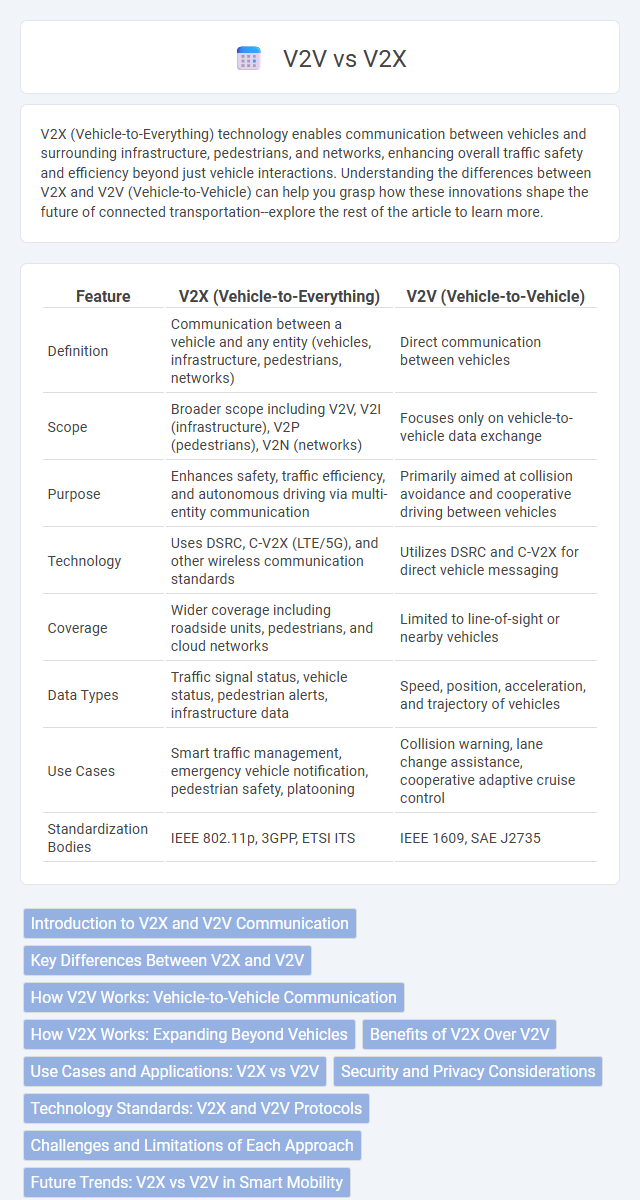V2X (Vehicle-to-Everything) technology enables communication between vehicles and surrounding infrastructure, pedestrians, and networks, enhancing overall traffic safety and efficiency beyond just vehicle interactions. Understanding the differences between V2X and V2V (Vehicle-to-Vehicle) can help you grasp how these innovations shape the future of connected transportation--explore the rest of the article to learn more.
Table of Comparison
| Feature | V2X (Vehicle-to-Everything) | V2V (Vehicle-to-Vehicle) |
|---|---|---|
| Definition | Communication between a vehicle and any entity (vehicles, infrastructure, pedestrians, networks) | Direct communication between vehicles |
| Scope | Broader scope including V2V, V2I (infrastructure), V2P (pedestrians), V2N (networks) | Focuses only on vehicle-to-vehicle data exchange |
| Purpose | Enhances safety, traffic efficiency, and autonomous driving via multi-entity communication | Primarily aimed at collision avoidance and cooperative driving between vehicles |
| Technology | Uses DSRC, C-V2X (LTE/5G), and other wireless communication standards | Utilizes DSRC and C-V2X for direct vehicle messaging |
| Coverage | Wider coverage including roadside units, pedestrians, and cloud networks | Limited to line-of-sight or nearby vehicles |
| Data Types | Traffic signal status, vehicle status, pedestrian alerts, infrastructure data | Speed, position, acceleration, and trajectory of vehicles |
| Use Cases | Smart traffic management, emergency vehicle notification, pedestrian safety, platooning | Collision warning, lane change assistance, cooperative adaptive cruise control |
| Standardization Bodies | IEEE 802.11p, 3GPP, ETSI ITS | IEEE 1609, SAE J2735 |
Introduction to V2X and V2V Communication
V2X (Vehicle-to-Everything) communication encompasses a broad range of connectivity between vehicles and external entities such as infrastructure, pedestrians, and networks, whereas V2V (Vehicle-to-Vehicle) specifically focuses on direct communication between vehicles. This technology enables real-time data exchange to improve traffic safety, reduce collisions, and optimize traffic flow. Your driving experience can benefit from enhanced situational awareness through these interconnected systems.
Key Differences Between V2X and V2V
V2X (Vehicle-to-Everything) communication encompasses a broad range of interactions including Vehicle-to-Vehicle (V2V), Vehicle-to-Infrastructure (V2I), Vehicle-to-Pedestrian (V2P), and Vehicle-to-Network (V2N), enhancing overall traffic safety and efficiency through diverse data exchanges. V2V specifically refers to direct communication between vehicles, enabling real-time alerts about speed, position, and road hazards to prevent collisions. Your understanding of these key differences helps optimize transportation technologies for safer and smarter mobility solutions.
How V2V Works: Vehicle-to-Vehicle Communication
V2V communication enables vehicles to exchange real-time information such as speed, position, and direction using dedicated short-range communication (DSRC) or cellular V2X (C-V2X) technologies. This data sharing allows your vehicle to anticipate hazards, avoid collisions, and improve traffic flow by coordinating with nearby cars. By leveraging V2V networks, vehicles create a connected environment that enhances road safety and driving efficiency.
How V2X Works: Expanding Beyond Vehicles
V2X technology enables communication not only between vehicles (V2V) but also with infrastructure, pedestrians, and cloud networks, enhancing overall traffic safety and efficiency. By integrating data from traffic signals, road sensors, and mobile devices, V2X systems provide your vehicle with real-time information about road conditions and potential hazards. This expansion beyond vehicle-to-vehicle communication supports smarter navigation and proactive accident prevention in connected transportation environments.
Benefits of V2X Over V2V
V2X communication expands beyond Vehicle-to-Vehicle (V2V) by including interactions with infrastructure, pedestrians, and networks, providing a more comprehensive safety and traffic management system. This broader connectivity enables real-time updates on road conditions, traffic signals, and potential hazards, significantly enhancing situational awareness and reducing accident risks. Your driving experience benefits from smoother traffic flow, improved fuel efficiency, and increased overall road safety through V2X technology.
Use Cases and Applications: V2X vs V2V
V2X (Vehicle-to-Everything) communication extends beyond V2V (Vehicle-to-Vehicle) by enabling connectivity between vehicles and infrastructure, pedestrians, networks, and other road users, supporting use cases like traffic signal timing optimization, pedestrian safety, and smart parking management. V2V specifically focuses on collision avoidance, lane change assistance, and cooperative adaptive cruise control by exchanging information directly between nearby vehicles. Both technologies enhance road safety and traffic efficiency, but V2X provides a broader scope of applications by integrating multiple elements of the transportation ecosystem.
Security and Privacy Considerations
V2X (Vehicle-to-Everything) communication extends beyond vehicle-to-vehicle (V2V) by connecting vehicles with infrastructure, pedestrians, and networks, which increases the attack surface for potential cyber threats. Security protocols in V2X must handle diverse data streams, incorporating robust encryption, authentication, and real-time threat detection to protect user data and ensure privacy. Your safety depends on the continuous evolution of these security measures to prevent unauthorized access, data spoofing, and privacy breaches in both V2V and broader V2X environments.
Technology Standards: V2X and V2V Protocols
V2X technology encompasses a broader communication framework, including Vehicle-to-Vehicle (V2V), Vehicle-to-Infrastructure (V2I), and Vehicle-to-Pedestrian (V2P), utilizing standards such as IEEE 802.11p and Cellular V2X (C-V2X) based on 3GPP releases. V2V communication specifically relies on protocols like Dedicated Short-Range Communications (DSRC) and the enhanced C-V2X Mode 4, enabling direct vehicle interactions without cellular network dependency. Both V2X and V2V standards focus on low latency and high reliability to support safety-critical applications and autonomous driving advancements.
Challenges and Limitations of Each Approach
V2X faces challenges such as spectrum allocation, infrastructure costs, and cybersecurity risks that limit widespread deployment. V2V encounters limitations in communication range, signal interference, and reliance on vehicle density for effective data exchange. Understanding these constraints helps you optimize the use of each technology for safer and more efficient transportation systems.
Future Trends: V2X vs V2V in Smart Mobility
Future trends in smart mobility highlight V2X (Vehicle-to-Everything) as a more comprehensive solution compared to V2V (Vehicle-to-Vehicle), enabling communication not only between vehicles but also with infrastructure, pedestrians, and networks. This expanded connectivity supports advanced applications like real-time traffic management, enhanced safety, and autonomous driving, driving the evolution of intelligent transportation systems. Your transportation experience will benefit from increased efficiency and safety as V2X technology integrates broader environmental data compared to the more limited scope of V2V communication.
V2X vs V2V Infographic

 electrown.com
electrown.com